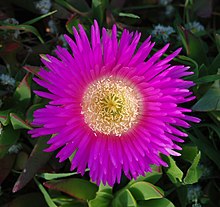Carpobrotus chilensis
However, along with its relative C. edulis, it has invaded sections of the California coast at the expense of native vegetation, and is subject to control efforts.
[1] It is similar to, and often mistaken for, its close relative the "ice plant" (Carpobrotus edulis), which is larger, and grows alongside and sometimes hybridizes with C. chilensis.
It is also found, and naturalised, in Argentina, Chile, Peru, Ecuador, Australia, Spain, Greece, Southern England and New Zealand.
Grown in sunny conditions, it is normally found within coastal dunes and bluffs, margins of estuaries, along roadsides; at elevations from sea level to 100 m (330 ft) along the southern Pacific Coast of North America.
It can be mixed with water and used to treat diarrhoea, dysentery and stomach cramps, and can also be gargled to alleviate laryngitis, sore throat and mouth infections.
